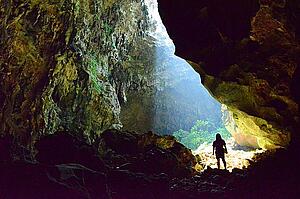Callao Caves
In April 2019, scientists announced that a new species of ancient human had been discovered in Callao Cave in the Philippines, which was previously known only as the home of Callao Man.

The discovery of the 4ft ancient human - now known as Homo luzonensis - points to the possibility that another human species was living on the archipelago as recently as 50,000 years ago. According to scientists, this makes the picture of early human evolution, both in the Philippines and around the world was a whole, far more “complicated” and “even messier” than was previously predicted.
Before Homo luzenesis was unearthed, the only human species found in the Callao Caves on Luzon was the Callao Man - an ancestor of modern Homo sapiens believed to have lived around 67,000 years ago. However, while Callao Man is thought to have arrived on the island by sea, scientists believe that Homo luzonensis could be one of many separate human species that evolved on islands in the region.

Discovered by Florent Detroit of the French National Museum of Natural History and Salvador Mijares at the ![]() University of the Philippines, the 12 fossils dug up in 2016 included seven teeth, two finger bones, two toe bones and part of a thigh bone. Some of the teeth have been dated as 50,000 years old and all the fossils found have been determined to be too primitive to belong to Homo Sapiens, the only surviving member of the group of ancestral humans known was hominins.
University of the Philippines, the 12 fossils dug up in 2016 included seven teeth, two finger bones, two toe bones and part of a thigh bone. Some of the teeth have been dated as 50,000 years old and all the fossils found have been determined to be too primitive to belong to Homo Sapiens, the only surviving member of the group of ancestral humans known was hominins.
According to the analysis of the bones, the teeth were very unusual as they shared characteristics with more primitive hominins but were so small they pointed to the individuals being shorter than 4ft. In addition, one of the foot bones was found to have anatomy distinct from all known hominins, while the curved toes were identical to those of Austraipithecus, a primitive species that lived in Africa at least two million years earlier than Homo luzonensis is thought to have lived.
Detroit and Mijares commented that the discovery of Homo luzonensis points to how much more we have to learn about early humans and the process of evolution. In their paper published in Nature, they said:
“The discovery of H luzonensis underscores the complexity of the evolution, dispersal and diversity of the genus Homo outside of Africa, and particularly in the islands of south-east Asia, during the Pleistocene.”
MLA Citation/Reference
"Callao Caves". HistoryLearning.com. 2026. Web.
